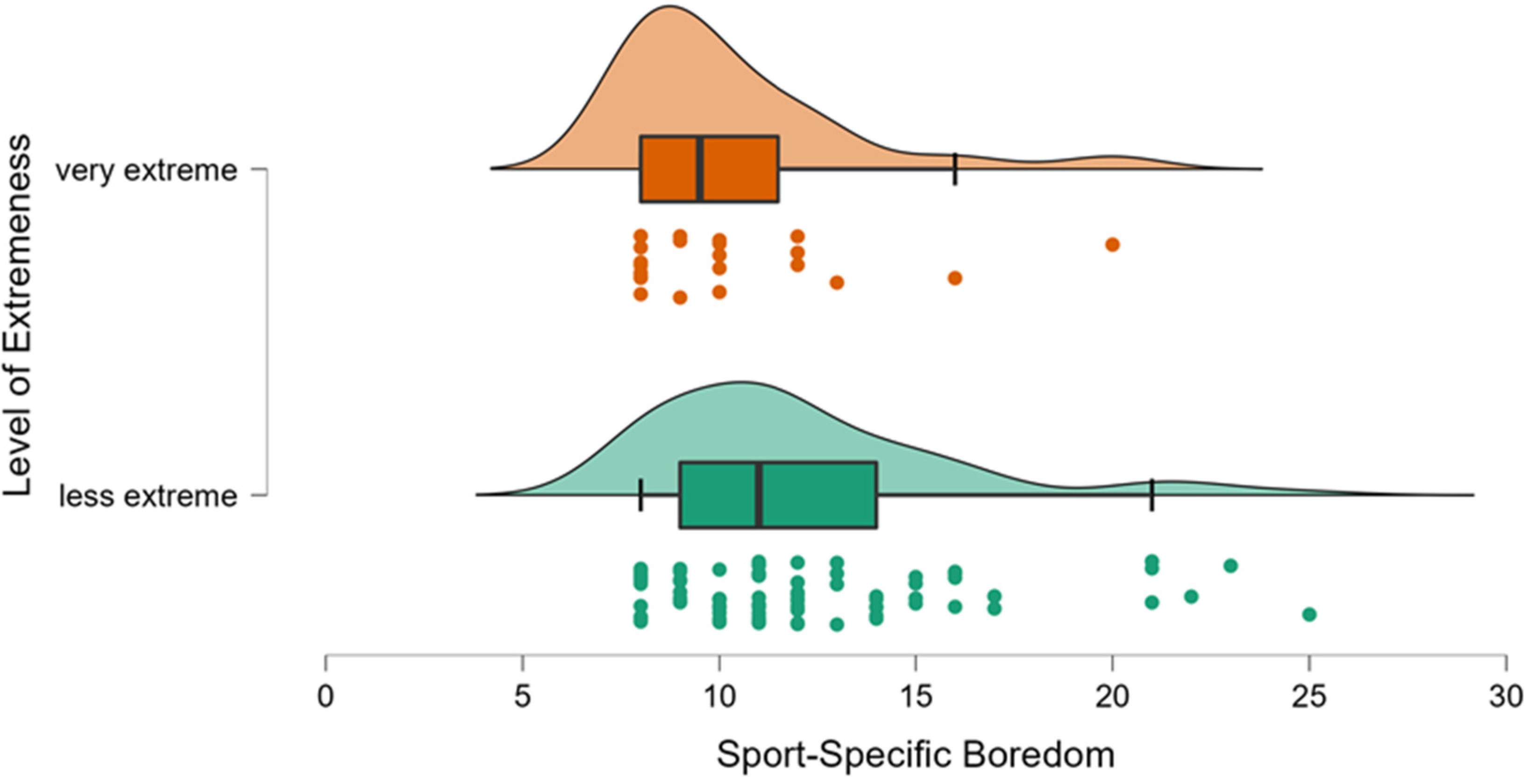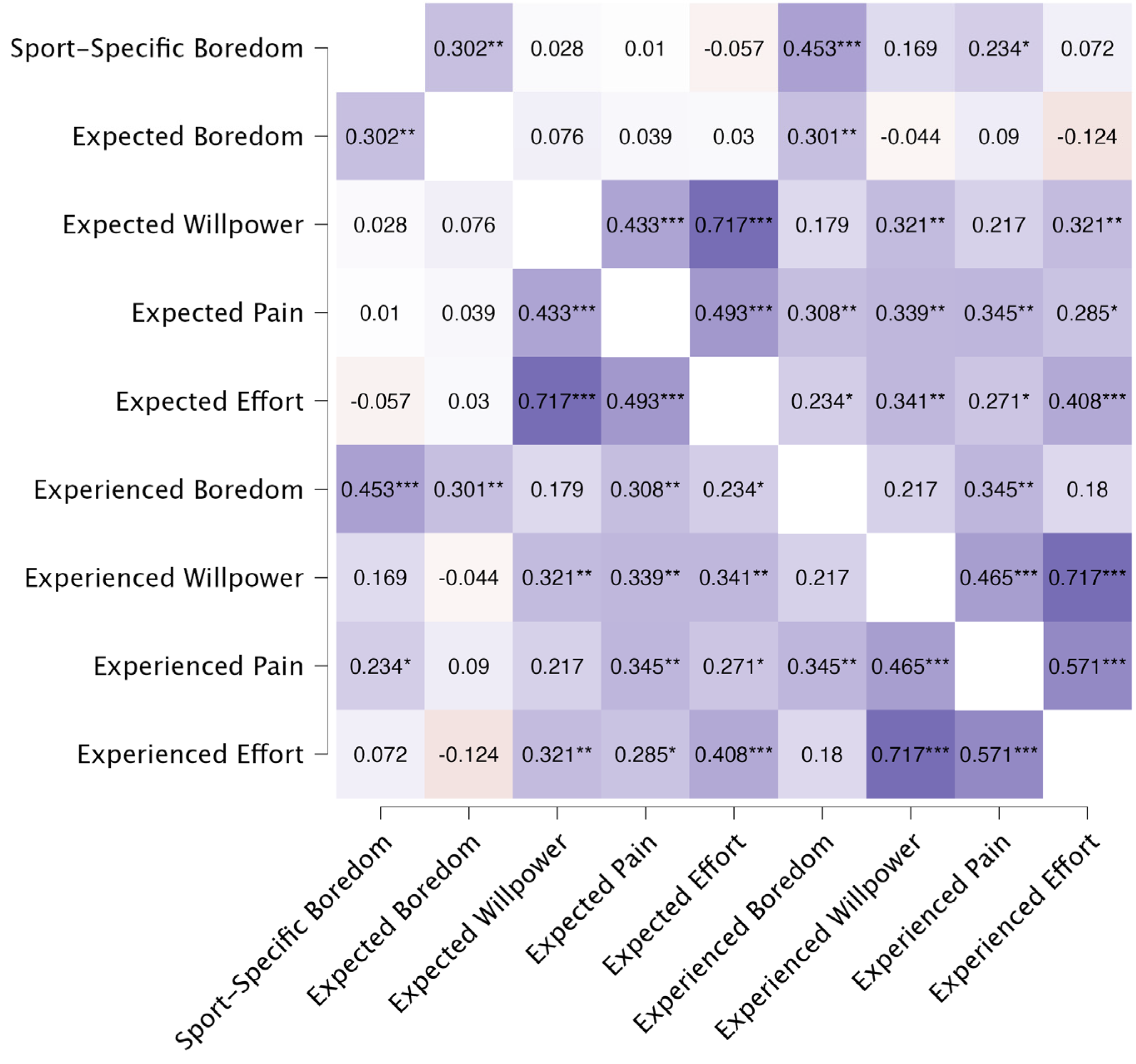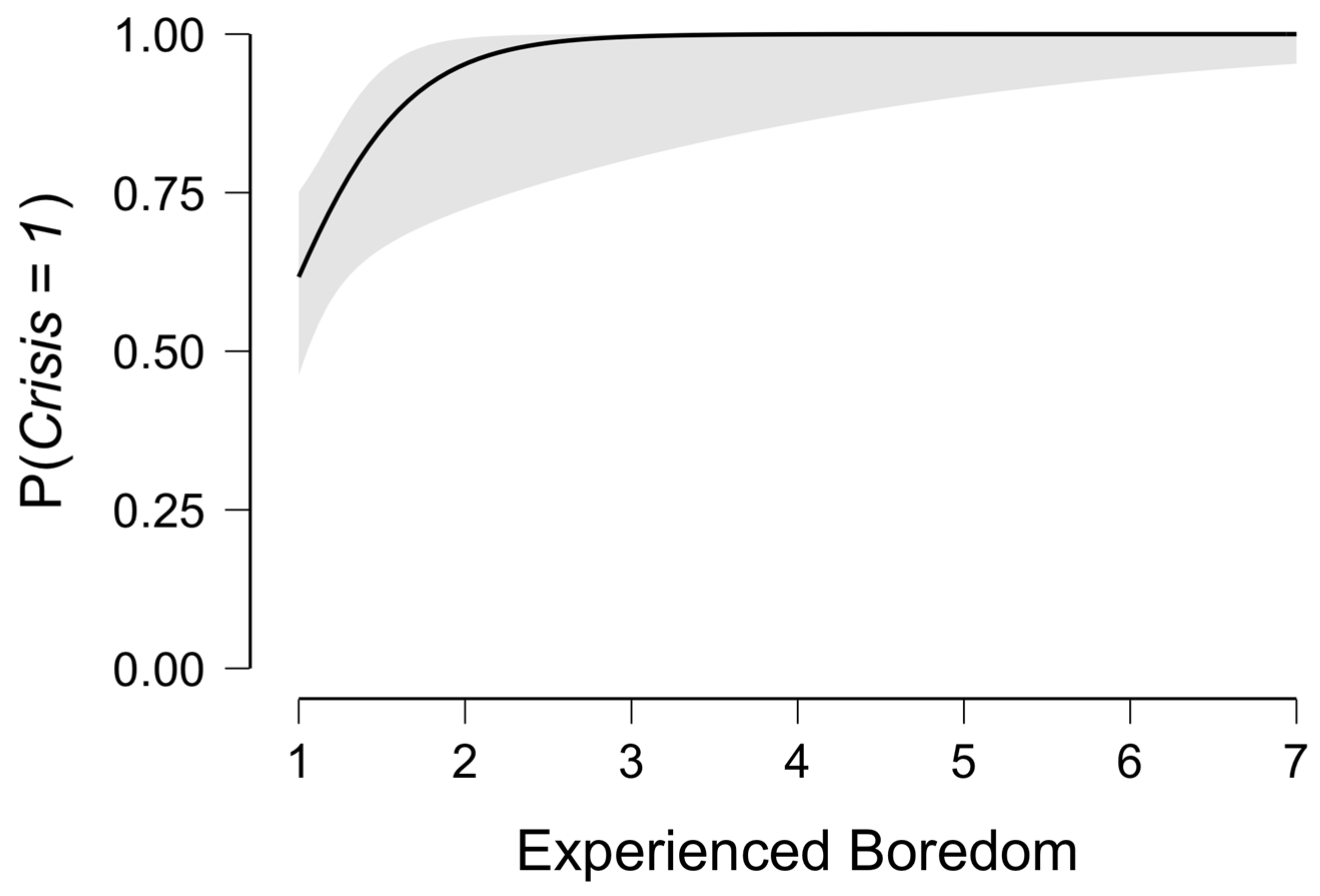24 Hours on the Run—Does Boredom Matter for Ultra-Endurance Athletes’ Crises?
Abstract
:1. Introduction
1.1. Trait Boredom and Ultra-Endurance Running
1.2. Self-Regulatory Challenges and Action Crises during Competition: The Role of State Boredom
1.3. The Present Study—24 Hours on the Run
2. Methods
2.1. Participants
2.2. Race Setting
2.3. Questionnaire
2.3.1. Expectation: Before the Race
2.3.2. Actual Experience: After the Race
2.4. Statistical Analysis
3. Results
3.1. Descriptive Statistics
3.2. Comparing Sport-Specific Trait Boredom between More or Less Extreme Athletes
3.3. Boredom during An Ultra-Endurance Competition
4. Discussion
4.1. Ultra-Endurance Athletes and Less Extreme Athletes Differ in Sport-Specific Boredom
4.2. Being Bored Is A Recipe for Tumbling into Crises
5. Limitations
6. Conclusions
Author Contributions
Funding
Institutional Review Board Statement
Informed Consent Statement
Data Availability Statement
Acknowledgments
Conflicts of Interest
References
- Eastwood, J.D.; Frischen, A.; Fenske, M.J.; Smilek, D. The Unengaged Mind: Defining Boredom in Terms of Attention. Perspect Psychol. Sci. 2012, 7, 482–495. [Google Scholar] [CrossRef] [PubMed]
- Bench, S.; Lench, H. On the Function of Boredom. Behav. Sci. 2013, 3, 459–472. [Google Scholar] [CrossRef] [PubMed] [Green Version]
- Vodanovich, S.J. Psychometric Measures of Boredom: A Review of the Literature. J. Psychol. 2003, 137, 569–595. [Google Scholar] [CrossRef] [PubMed]
- Vodanovich, S.J.; Watt, J.D. Self-Report Measures of Boredom: An Updated Review of the Literature. J. Psychol. 2016, 150, 196–228. [Google Scholar] [CrossRef]
- Wolff, W.; Bieleke, M.; Stähler, J.; Schüler, J. Too Bored for Sports? Adaptive and Less-Adaptive Latent Personality Profiles for Exercise Behavior. Psychol. Sport Exerc. 2021, 53, 101851. [Google Scholar] [CrossRef]
- Westgate, E.C.; Wilson, T.D. Boring Thoughts and Bored Minds: The MAC Model of Boredom and Cognitive Engagement. Psychol. Rev. 2018, 125, 689–713. [Google Scholar] [CrossRef]
- Wilson, T.D.; Reinhard, D.A.; Westgate, E.C.; Gilbert, D.T.; Ellerbeck, N.; Hahn, C.; Brown, C.L.; Shaked, A. Just Think: The Challenges of the Disengaged Mind. Science 2014, 345, 75–77. [Google Scholar] [CrossRef] [Green Version]
- Pfattheicher, S.; Lazarević, L.B.; Westgate, E.C.; Schindler, S. On the Relation of Boredom and Sadistic Aggression. J. Personal. Soc. Psychol. 2021, 121, 573–600. [Google Scholar] [CrossRef]
- Park, G.; Lim, B.-C.; Oh, H.S. Why Being Bored Might Not Be a Bad Thing after All. AMD 2019, 5, 78–92. [Google Scholar] [CrossRef]
- Bieleke, M.; Barton, L.; Wolff, W. Trajectories of Boredom in Self-Control Demanding Tasks. Cogn. Emot. 2021, 35, 1018–1028. [Google Scholar] [CrossRef]
- Wolff, W.; Martarelli, C.S. Bored Into Depletion? Toward a Tentative Integration of Perceived Self-Control Exertion and Boredom as Guiding Signals for Goal-Directed Behavior. Perspect Psychol. Sci. 2020, 15, 1272–1283. [Google Scholar] [CrossRef] [PubMed]
- Gomez-Ramirez, J.; Costa, T. Boredom Begets Creativity: A Solution to the Exploitation–Exploration Trade-off in Predictive Coding. Biosystems 2017, 162, 168–176. [Google Scholar] [CrossRef] [PubMed]
- Bieleke, M.; Wolff, W. It’s Not a Bug, It’s Boredom: Effortful Willpower Balances Exploitation and Exploration. Behav. Brain Sci. 2021, 44, e33. [Google Scholar] [CrossRef] [PubMed]
- Milyavskaya, M.; Inzlicht, M.; Johnson, T.; Larson, M.J. Reward Sensitivity Following Boredom and Cognitive Effort: A High-Powered Neurophysiological Investigation. Neuropsychologia 2019, 123, 159–168. [Google Scholar] [CrossRef] [PubMed] [Green Version]
- Mangin, T.; André, N.; Benraiss, A.; Pageaux, B.; Audiffren, M. No Ego-Depletion Effect without a Good Control Task. Psychol. Sport Exerc. 2021, 57, 102033. [Google Scholar] [CrossRef]
- Wu, R.; Ferguson, A.M.; Inzlicht, M. Do Humans Prefer Cognitive Effort over Doing Nothing? psyarXiv 2021. [Google Scholar] [CrossRef]
- De Oliveira, L.; Carvalho, J. The Link Between Boredom and Hypersexuality: A Systematic Review. J. Sex. Med. 2020, 17, 994–1004. [Google Scholar] [CrossRef]
- Miao, P.; Li, X.; Xie, X. Hard to Bear: State Boredom Increases Financial Risk Taking. Soc. Psychol. 2020, 51, 157–170. [Google Scholar] [CrossRef]
- Tze, V.M.C.; Daniels, L.M.; Klassen, R.M. Evaluating the Relationship Between Boredom and Academic Outcomes: A Meta-Analysis. Educ. Psychol. Rev. 2016, 28, 119–144. [Google Scholar] [CrossRef]
- Mason, P. Satellite Tracking Helps Marathon de Sables Participants Keep on Running; Land Mobile: London, UK, 2019. [Google Scholar]
- Smith, R.P. Boredom: A Review. Hum. Factors 1981, 23, 329–340. [Google Scholar] [CrossRef]
- Westgate, E.C. Why Boredom Is Interesting. Curr. Dir. Psychol. Sci. 2020, 29, 33–40. [Google Scholar] [CrossRef] [Green Version]
- Scheer, V. Participation Trends of Ultra Endurance Events. Sports Med. Arthrosc. Rev. 2019, 27, 3–7. [Google Scholar] [CrossRef] [PubMed]
- Friedrich, K. Kein Sport Ist Auch Keine Lösung: Das ultimative Motivationsprogramm für Bewegungsmuffel; Patmos Verlag: Ostfildern, Germany, 2021; ISBN 978-3-8436-1321-7. [Google Scholar]
- Moynihan, A.B.; Igou, E.R.; van Tilburg, W.A.P. Existential Escape of the Bored: A Review of Meaning-Regulation Processes under Boredom. Eur. Rev. Soc. Psychol. 2021, 32, 161–200. [Google Scholar] [CrossRef]
- Opaschowski, H.W. Xtrem: Der kalkulierte Wahnsinn; Extremsport als Zeitphänomen, 9th ed.; Germa Press: Hamburg, Germany, 2000; ISBN 978-3-924865-33-7. [Google Scholar]
- Hoffman, M.D.; Krouse, R. Ultra-Obligatory Running among Ultramarathon Runners. Res. Sports Med. 2018, 26, 211–221. [Google Scholar] [CrossRef] [PubMed]
- Fullerton, C. Self-Control in Sport—Does Willpower Resemble a Muscle? In Sport and Exercise Psychology; Routledge: Abingdon, UK, 2015; pp. 105–120. [Google Scholar]
- Hoffer, A.; Giddings, L. Exercising Willpower: Differences in Willpower Depletion among Athletes and Nonathletes. Contemp. Econ. Policy 2016, 34, 463–474. [Google Scholar] [CrossRef]
- Meijen, C. (Ed.) Endurance Performance in Sport: Psychological Theory and Interventions; Routledge: New York, NY, USA, 2019; ISBN 978-1-138-05319-9. [Google Scholar]
- Wolff, W.; Hirsch, A.; Bieleke, M.; Shenhav, A. Neuroscientific Approaches to Self-Regulatory Control in Sports. In Motivation and Self-Regulation in Sport and Exercise; Routledge: New York, NY, USA, 2021; pp. 149–165. ISBN 978-1-00-317669-5. [Google Scholar]
- Best, R.; Barwick, B.; Best, A.; Berger, N.; Harrison, C.; Wright, M.; Sparrow, J. Changes in Pain and Nutritional Intake Modulate Ultra-Running Performance: A Case Report. Sports 2018, 6, 111. [Google Scholar] [CrossRef] [Green Version]
- Freund, W.; Weber, F.; Billich, C.; Birklein, F.; Breimhorst, M.; Schuetz, U.H. Ultra-Marathon Runners Are Different: Investigations into Pain Tolerance and Personality Traits of Participants of the TransEurope FootRace 2009. Pain Pract. 2013, 13, 524–532. [Google Scholar] [CrossRef]
- Hoffman, M.D.; Lee, J.; Zhao, H.; Tsodikov, A. Pain Perception After Running a 100-Mile Ultramarathon. Arch. Phys. Med. Rehabil. 2007, 88, 1042–1048. [Google Scholar] [CrossRef]
- Rochat, N.; Gesbert, V.; Seifert, L.; Hauw, D. Enacting Phenomenological Gestalts in Ultra-Trail Running: An Inductive Analysis of Trail Runners’ Courses of Experience. Front. Psychol. 2018, 9, 2038. [Google Scholar] [CrossRef] [Green Version]
- Bray, S.R.; Graham, J.D.; Saville, P.D. Self-Control Training Leads to Enhanced Cardiovascular Exercise Performance. J. Sports Sci. 2015, 33, 534–543. [Google Scholar] [CrossRef]
- Englert, C. Ego Depletion in Sports: Highlighting the Importance of Self-Control Strength for High-Level Sport Performance. Curr. Opin. Psychol. 2017, 16, 1–5. [Google Scholar] [CrossRef] [PubMed] [Green Version]
- Salwin, E.; Zajac, A. Pain Tolerance in Sport. BJHPA 2016, 8, 71–80. [Google Scholar] [CrossRef]
- Johnson, M.H.; Stewart, J.; Humphries, S.A.; Chamove, A.S. Marathon Runners’ Reaction to Potassium Iontophoretic Experimental Pain: Pain Tolerance, Pain Threshold, Coping and Self-Efficacy: Pain and Marathon Running. EJP 2012, 16, 767–774. [Google Scholar] [CrossRef]
- Deroche, T.; Woodman, T.; Stephan, Y.; Brewer, B.W.; Le Scanff, C. Athletes’ Inclination to Play through Pain: A Coping Perspective. Anxiety Stress Coping 2011, 24, 579–587. [Google Scholar] [CrossRef] [PubMed]
- Corrion, K.; Morales, V.; Bergamaschi, A.; Massiera, B.; Morin, J.-B.; d’Arripe-Longueville, F. Psychosocial Factors as Predictors of Dropout in Ultra-Trailers. PLoS ONE 2018, 13, e0206498. [Google Scholar] [CrossRef] [Green Version]
- Brandstätter, V.; Schüler, J. Action Crisis and Cost–Benefit Thinking: A Cognitive Analysis of a Goal-Disengagement Phase. J. Exp. Soc. Psychol. 2013, 49, 543–553. [Google Scholar] [CrossRef] [Green Version]
- Velasco, F.; Jorda, R. Portrait of Boredom Among Athletes and Its Implications in Sports Management: A Multi-Method Approach. Front. Psychol. 2020, 11, 831. [Google Scholar] [CrossRef]
- Bieleke, M.; Gogol, K.; Goetz, T.; Daniels, L.; Pekrun, R. The AEQ-S: A Short Version of the Achievement Emotions Questionnaire. Contemp. Educ. Psychol. 2021, 65, 101940. [Google Scholar] [CrossRef]
- Kohl, H.W.; Craig, C.L.; Lambert, E.V.; Inoue, S.; Alkandari, J.R.; Leetongin, G.; Kahlmeier, S. The Pandemic of Physical Inactivity: Global Action for Public Health. Lancet 2012, 380, 294–305. [Google Scholar] [CrossRef] [Green Version]
- Guthold, R.; Stevens, G.A.; Riley, L.M.; Bull, F.C. Worldwide Trends in Insufficient Physical Activity from 2001 to 2016: A Pooled Analysis of 358 Population-Based Surveys with 1·9 Million Participants. Lancet Glob. Health 2018, 6, e1077–e1086. [Google Scholar] [CrossRef] [Green Version]
- McCurdy, A.; Stearns, J.A.; Rhodes, R.E.; Hopkins, D.; Mummery, K.; Spence, J.C. Relationships Between Physical Activity, Boredom Proneness, and Subjective Well-Being Among U.K. Adults During the COVID-19 Pandemic. J. Sport Exerc. Psychol. 2022, 44, 189–197. [Google Scholar] [CrossRef] [PubMed]
- Danckert, J.; Mugon, J.; Struk, A.; Eastwood, J. Boredom: What Is It Good For? In The Function of Emotions; Lench, H.C., Ed.; Springer International Publishing: Cham, Switzerland, 2018; pp. 93–119. ISBN 978-3-319-77618-7. [Google Scholar]
- Knechtle, B. Ultramarathon Runners: Nature or Nurture? Int. J. Sports Physiol. Perform. 2012, 7, 310–312. [Google Scholar] [CrossRef] [PubMed] [Green Version]
- Wolff, W.; Bertrams, A.; Schüler, J. Trait Self-Control Discriminates Between Youth Football Players Selected and Not Selected for the German Talent Program: A Bayesian Analysis. Front. Psychol. 2019, 10, 2203. [Google Scholar] [CrossRef] [PubMed]
- Haney, T.A., Jr.; Mercer, J.A. A Description of Variability of Pacing in Marathon Distance Running. Int. J. Exerc. Sci. 2011, 4, 133. [Google Scholar]
- Jackson, S.A.; Csikszentmihalyi, M. Flow in Sports; Human Kinetics: Champaign, IL, USA, 1999; ISBN 978-0-88011-876-7. [Google Scholar]
- Fitzgerald, M. How Bad Do You Want It? In Mastering the Psychology of Mind over Muscle; VeloPress: Boulder, CO, USA, 2015; ISBN 978-1-937715-41-0. [Google Scholar]
- Overbye, M. Walking the Line? An Investigation into Elite Athletes’ Sport-Related Use of Painkillers and Their Willingness to Use Analgesics to Train or Compete When Injured. Int. Rev. Sociol. Sport 2021, 56, 1091–1115. [Google Scholar] [CrossRef]
- Mateo, A. 10 Expert Tips to Beat Mental Boredom During a Marathon. Runner’s World, 29 October 2018; p. 1. [Google Scholar]
- Karageorghis, C.I.; Terry, P.C. The Psychophysical Effects of Music in Sport and Exercise: A Review. J. Sport Behav. 1997, 20, 54. [Google Scholar]
- Mills, C.; Christoff, K. Finding Consistency in Boredom by Appreciating Its Instability. Trends Cogn. Sci. 2018, 22, 744–747. [Google Scholar] [CrossRef]





| Very Extreme Athletes | ||||||
|---|---|---|---|---|---|---|
| N | Age | Weekly Training (km) | Avg. Event Distance (km) | Max. Event Distance (km) | Sport-Specific Boredom (Avg. Mean Score) | |
| male | 18 | 44.4 ± 14.9 | 72.8 ± 33.6 | 110.7 ± 55.7 | 197 | 1.27 ± 0.37 |
| female | 5 | 37.0 ± 9.4 | 60.0 ± 39.6 | 82.5 ± 57.3 | 123 | 1.32 ± 0.43 |
| all | 23 | 43.9 ± 13.7 | 72.6 ± 34.0 | 104.8 ± 54.4 | 197 | 1.28 ± 0.37 |
| Less Extreme Athletes | ||||||
| N | Age | Weekly Training (km) | Avg. Event Distance (km) | Max. Event Distance (km) | Sport-Specific Boredom (Avg. Mean Score) | |
| male | 54 | 38.5 ± 13.3 | 37.5 ± 21.4 | 54.9 ± 14.3 | 101 | 1.54 ± 0.53 |
| female | 30 | 31.8 ± 12.4 | 33.6 ± 15.5 | 43.8 ± 13.2 | 80 | 1.46 ± 0.35 |
| all | 84 | 36.0 ± 13.3 | 35.3 ± 19.6 | 50.7 ± 14.8 | 101 | 1.50 ± 0.46 |
Publisher’s Note: MDPI stays neutral with regard to jurisdictional claims in published maps and institutional affiliations. |
© 2022 by the authors. Licensee MDPI, Basel, Switzerland. This article is an open access article distributed under the terms and conditions of the Creative Commons Attribution (CC BY) license (https://creativecommons.org/licenses/by/4.0/).
Share and Cite
Weich, C.; Schüler, J.; Wolff, W. 24 Hours on the Run—Does Boredom Matter for Ultra-Endurance Athletes’ Crises? Int. J. Environ. Res. Public Health 2022, 19, 6859. https://doi.org/10.3390/ijerph19116859
Weich C, Schüler J, Wolff W. 24 Hours on the Run—Does Boredom Matter for Ultra-Endurance Athletes’ Crises? International Journal of Environmental Research and Public Health. 2022; 19(11):6859. https://doi.org/10.3390/ijerph19116859
Chicago/Turabian StyleWeich, Christian, Julia Schüler, and Wanja Wolff. 2022. "24 Hours on the Run—Does Boredom Matter for Ultra-Endurance Athletes’ Crises?" International Journal of Environmental Research and Public Health 19, no. 11: 6859. https://doi.org/10.3390/ijerph19116859
APA StyleWeich, C., Schüler, J., & Wolff, W. (2022). 24 Hours on the Run—Does Boredom Matter for Ultra-Endurance Athletes’ Crises? International Journal of Environmental Research and Public Health, 19(11), 6859. https://doi.org/10.3390/ijerph19116859






